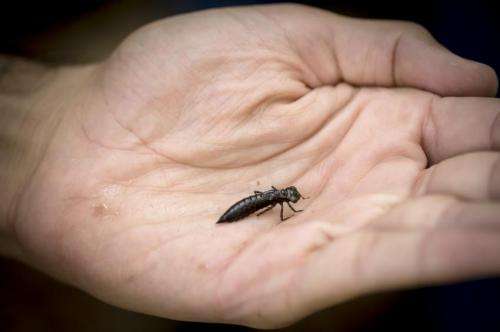Ecology research paper wins national award

Humans are known to alter the planet. One efficient way is by adding new species to ecosystems. People accidentally (and oftentimes deliberately) transport species from place to place in airplanes, boats and cars. Humans are known, too, to even remove a species entirely from its ecosystem by overhunting or by destroying the species' habitat. What, if any, are the consequences of such actions? How do they impact ecosystems?
In May 2014, Ashkaan K. Fahimipour, a fourth-year Ph.D. student in the Department of Biology at the University of California, Riverside, and a colleague published a research paper in Ecology Letters, a top journal in the field of ecology, in which they manipulated many ecosystems at once to examine how the connections between species change over time.
That paper, titled "The Dynamics of Assembling Food Webs," has now been selected as this year's recipient of the Thomas M. Frost Award for Excellence in Graduate Research, sponsored by the aquatic section of the Ecological Society of America. Named for a creative scientist, the prize honors his commitment to aquatic ecology and graduate student education.
Fahimipour and coauthor Andrew M. Hein of Princeton University will receive a plaque and a cash award this month in Sacramento, Calif., at the 99th annual meeting of the Ecological Society of America.
"This study is really important because Ashkaan and his colleague followed the linkages among the species over a long time span; I know of no other experiment that does this," said Kurt E. Anderson, an assistant professor of biology at UC Riverside and Fahimipour's adviser. "The uniqueness of their data has already attracted great attention, with Ashkaan fielding many requests for data by researchers who are interested in conducting further analyses."
Fahimipour explained that ecosystems are collections of plants, animals, and other living things that grow and interact with one another around us. To protect and preserve our environment, we need to understand how they work, he said.
"If we're going to avoid destroying the environment around us, we need to understand how species are linked to one another and how our actions affect these linkages," he said. "But it's hard to look at a whole ecosystem such as an Alaskan forest or an African savanna at once because they are so big."
To circumvent this problem, ecologists often settle for smaller ecosystems to study and manipulate in a controlled way—which is just how Fahimipour and Hein proceeded. In their study, one of the few to look at how linkages between species change through time, they studied small ponds (42plastic wading pools) and more than 130 species—including algae, zooplankton, microcrustaceans, mosquitoes, flies, beetles, dragonflies, tadpoles and hitch-hiking mites—they encountered living in them. They found many patterns that have never been seen before—such as changes in the network structure of interacting plants and animals within these ecosystems.
To do the research, Fahimipour and Hein added species (a mixture of zooplankton and insects) to half of their artificial ponds. In the remaining half they added no species. They then laboriously tracked all the species in all the ponds for about 10 weeks, which allowed them to study how species' interactions changed over the course of the experiment.
"What our experiments showed us is that life is unfair in these little ponds—to put it simply," Fahimipour said. "A few species consume almost all of the resources and thrived. The rest did not, and dwindled in number. Many studies have shown that nature seems to exhibit striking regularities across habitats. So, if you look at a lake in North America and compare it to a community of soil microbes in Asia, they will have certain similarities, especially regarding the way in which species are connected to one another via interactions. Our study makes a step toward understanding how and why these regularities arise using a model system."
Because ecosystems are always changing, Fahimipour and Hein conclude that an ecosystem has to be examined more than once to understand how it works.
"These types of studies are rare," Fahimipour said. "It's a matter of theory far outpacing data in a scientific field. We have all of these ideas from mathematical models and simulations about how ecosystems should change through time, but no one has actually observed these hypothesized patterns before. We need to start understanding these changes over time. This is because ecosystems are so variable, and something that we learn about a particular ecosystem today may not be useful tomorrow because they change so rapidly."
Journal information: Ecology Letters
Provided by University of California - Riverside

















